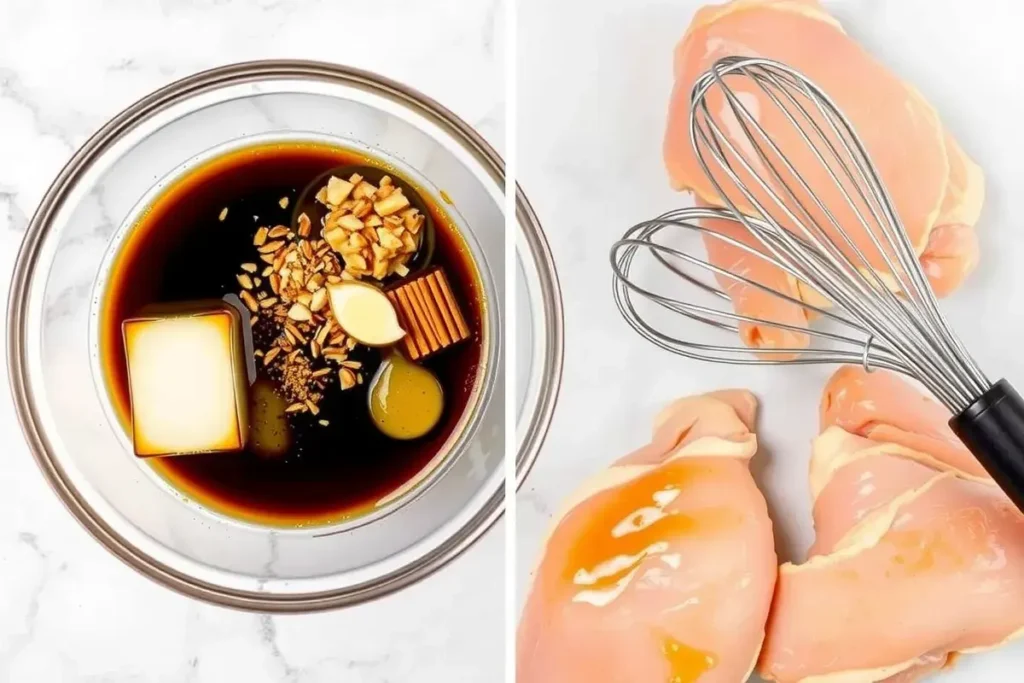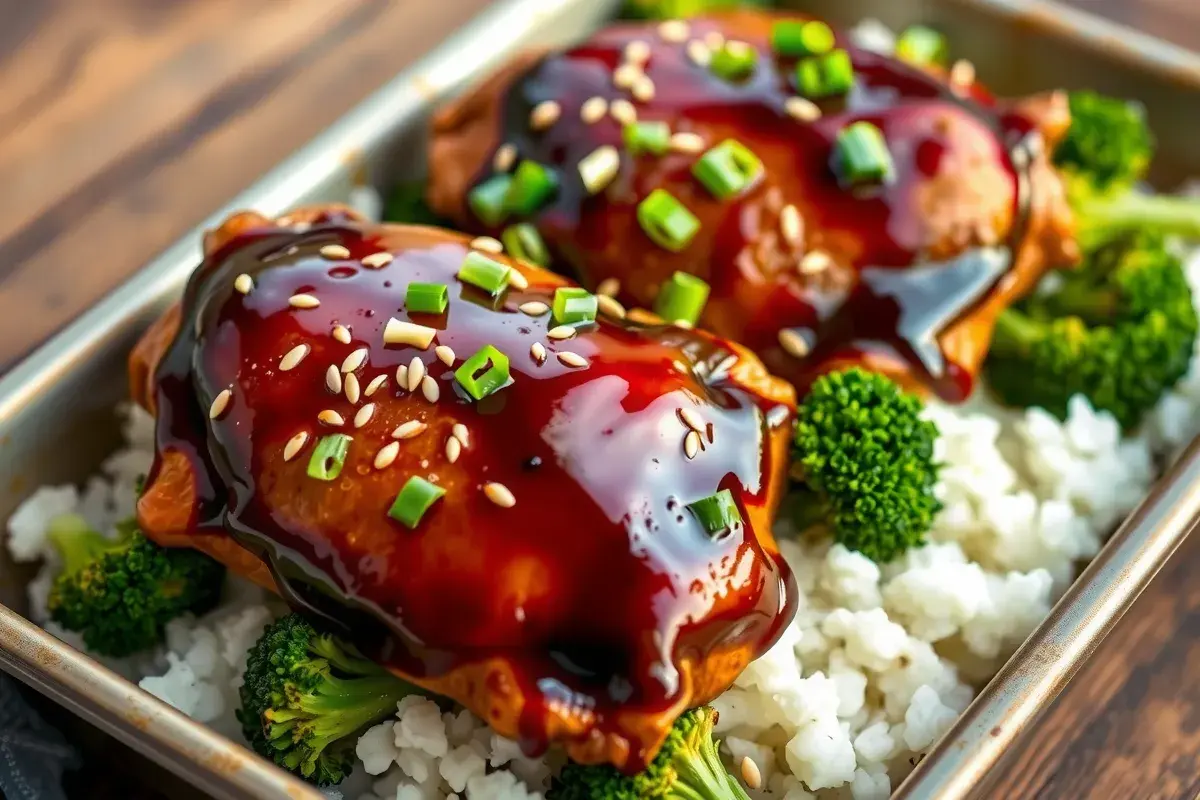Teriyaki sauce is sweet, savory, and full of umami. Yet, its true magic emerges when paired with juicy chicken thighs. Baked teriyaki chicken thighs offer mouthwatering flavor, tender texture, and a simple cooking method. Therefore, they’ve become a staple in many households. This comprehensive guide covers every detail, from sourcing ingredients to storing leftovers. Above all, it aims to help you master this timeless dish.
In the following sections, you’ll learn about the rich history of teriyaki, the best ways to marinate chicken thighs, and proven baking techniques. Additionally, you’ll find smart tips on side dishes and serving ideas. Whether you’re a novice cook or a kitchen pro, these insights will help you create a meal worth remembering.
Moreover, you’ll discover how to reduce mistakes, harness the power of homemade sauces, and maintain food safety. To keep things interesting, each section contains practical tips and action steps. Meanwhile, sprinkled throughout are bullet points for clarity and quick reference. Get ready to explore the tasty world of baked teriyaki chicken thighs.
The Rich Origin of Teriyaki
Teriyaki has deep roots in Japanese cooking. Traditionally, teri means “glaze” and yaki means “grill” or “broil.” The word describes a technique where proteins receive a shiny coating of soy sauce and sweet mirin. However, variations have emerged worldwide as people adapt it to their tastes.
A Brief History
- Early Japanese Roots: Teriyaki sauce evolved from classic Japanese cooking methods. Chefs used soy sauce, sugar, and sake or mirin to create an appealing sheen on grilled fish.
- Global Influence: As Japanese immigrants arrived in places like Hawaii and North America, they tailored teriyaki to local ingredients. Consequently, the sauce took on bolder, sweeter flavors with added pineapple juice or brown sugar.
- Modern Adaptations: Today, baked teriyaki chicken thighs are popular in kitchens everywhere. In contrast to open-flame grilling, baking highlights the sauce’s sweetness and locks in moisture.
Teriyaki’s origin story shows how cultural exchange enriches food. For example, the Japanese marinade technique has combined seamlessly with Western baking traditions. Above all, the method remains simple: marinate, cook, and serve.
Why Teriyaki Thrives
Teriyaki’s quick rise to fame isn’t just because it’s delicious. The sauce ingredients are both affordable and simple to find:
- Soy sauce: Savory and rich, it forms teriyaki’s base.
- Sweeteners: Brown sugar, honey, or mirin balance the soy sauce’s saltiness.
- Aromatic elements: Garlic, ginger, or onion powder enhance depth of flavor.
As a result, teriyaki chicken thighs baked to perfection stand out on any dinner table. Furthermore, the dish’s approachable nature means it fits busy lifestyles. Beginners love its reliability, and experienced cooks appreciate its adaptability.
Why Choose Chicken Thighs for Teriyaki Dishes?
Chicken thighs are an excellent choice for teriyaki. They remain juicy during cooking and handle high heat well. When you opt for baked teriyaki chicken thighs, you take advantage of a cut that naturally stays moist. In addition, thighs tend to be more flavorful than chicken breasts.
Flavor & Texture Benefits
- Higher Fat Content: This results in tenderness and succulence.
- More Intense Taste: Thighs carry a richer chicken flavor, which pairs beautifully with teriyaki sauce.
- Even Cooking: Thighs bake consistently, so it’s easier to avoid dry, overcooked spots.
Moreover, thighs adapt well to marinades. The sauce can penetrate deeply, ensuring every bite bursts with flavor. However, it’s important to choose bone-in or boneless depending on your preference. Bone-in provides extra richness, while boneless cooks more quickly.
Versatility in Meals
Baked teriyaki chicken thighs work well in countless settings:
- Weeknight Dinners: They’re easy to prepare in bulk, so you can feed a family without hassle.
- Meal Prep: Thighs reheat beautifully. Therefore, they’re perfect for weekday lunches.
- Party Platters: Their succulent texture and vibrant glaze stand out on a buffet table.
Additionally, you can incorporate them into various cuisines. For example, shred leftover thighs for teriyaki tacos. Or slice them thinly for a teriyaki-infused stir-fry. This versatility makes them invaluable.
Nutritional Profile
Although some people shy away from dark meat, it’s a nutrient powerhouse:
- Iron & Zinc: Dark meat contains more minerals than breast meat.
- Collagen & Gelatin: Bones in bone-in thighs add beneficial proteins when cooked for longer periods.
- Healthy Fats: The moderate fat content includes both monounsaturated and polyunsaturated fats.
Still, it’s important to practice balance. Pair your baked teriyaki chicken thighs with fiber-rich vegetables for a well-rounded plate.
Preparing the Perfect Marinade for Baked Teriyaki Chicken Thighs

A marinade can make or break your teriyaki chicken. Therefore, putting effort into this stage pays off significantly. Teriyaki marinade typically includes soy sauce, sugar or honey, aromatic spices, and sometimes mirin or sake. It’s easy to modify this recipe to suit your dietary preferences or local ingredient availability.
Marinade Essentials
Below is a simple marinade recipe:
- Soy Sauce (½ cup): Forms the savory base.
- Brown Sugar (3 tablespoons): Adds sweetness and depth.
- Honey (2 tablespoons): Gives a silky sweetness.
- Garlic (2 cloves, minced): Brings out pungent flavor.
- Ginger (1 teaspoon, grated): Adds a subtle spicy note.
- Mirin or Dry Sherry (2 tablespoons): Offers a sweet, mildly acidic tang.
- Sesame Oil (1 tablespoon): Contributes a nutty aroma.
Combine these ingredients in a large bowl. Then stir them thoroughly. Before you add the chicken, taste the marinade. Adjust sugar or soy sauce based on preference.
Marinating Best Practices
- Time: Marinate for at least 30 minutes. However, 2–4 hours yields a more profound flavor.
- Refrigeration: Keep marinating chicken thighs in the fridge to maintain food safety.
- Container: A sealable plastic bag or glass container helps the marinade coat all sides.
If you prefer a thicker sauce, simmer the marinade in a small saucepan after you remove the raw chicken. Then, reduce it to a syrupy consistency. This extra step ensures you get a thick glaze to brush on your baked teriyaki chicken thighs later.
Marinade Variations
For extra flair, experiment with additional elements:
- Pineapple Juice: Provides a tropical sweetness.
- Chili Flakes: Bring a touch of heat.
- Orange Zest: Infuses citrusy brightness.
Remember to keep a balance between sweet, salty, and acidic. That way, your baked teriyaki chicken thighs will maintain their signature harmony.
Step-by-Step Guide to Baking Teriyaki Chicken Thighs
Baking chicken thighs might seem straightforward. Yet, a few key steps make the difference between a good meal and a spectacular one. In this section, you’ll learn how to transform marinated thighs into succulent, oven-baked teriyaki chicken thighs.
Preparation & Preheating
- Preheat your oven: Set it to 400°F (200°C).
- Line a baking sheet: Use parchment paper or aluminum foil for easy cleanup.
- Remove thighs from marinade: Let excess marinade drip off.
- Arrange on the sheet: Place thighs skin-side up or smooth side up if skinless.
It’s crucial to leave space between each thigh. Therefore, the hot air circulates evenly.
Initial Bake
- Bake for 20 minutes: Check halfway to ensure even cooking. Rotate the pan if necessary.
- Flip or Not?: Typically, flipping chicken thighs is optional. However, flipping can help maintain a balanced glaze.
During these initial 20 minutes, the chicken’s internal temperature will rise steadily. Moreover, the outer glaze will start caramelizing.
Glaze & Broil
After 20 minutes, remove the baking sheet from the oven. Brush the thighs with additional teriyaki sauce or reduced marinade. Then place them back in the oven. Often, you’ll bake for another 10 to 15 minutes. For an even richer caramelization, switch to the broil setting for the last 2 minutes. This step ensures the baked teriyaki chicken thighs develop a sticky, golden finish.
Check for Doneness
Use a meat thermometer to verify the internal temperature. Chicken thighs should reach 165°F (74°C) in the thickest part. Consequently, you’ll avoid both undercooking and overcooking.
Quick Tips for Perfection
- If you see scorching sauce edges, reduce the oven temperature.
- For a less sweet finish, brush on a lighter layer of glaze.
- Always rest the thighs for 5 minutes before slicing.
This step-by-step approach guarantees consistency. Furthermore, it sets the stage for succulent results.
Enhancing Flavor with Homemade Teriyaki Sauce
While bottled teriyaki sauce is convenient, homemade sauce tastes fresher and lets you control the sugar content. Above all, it aligns with the original Japanese concept. If you want to elevate your baked teriyaki chicken thighs, crafting a homemade sauce is a worthwhile step.
Basic Homemade Sauce Recipe
Here’s a simple teriyaki sauce that pairs beautifully with chicken thighs:
- Soy Sauce (½ cup)
- Brown Sugar (2 tablespoons)
- Honey (1 tablespoon)
- Minced Garlic (1 clove)
- Grated Ginger (½ teaspoon)
- Cornstarch Slurry: 1 tablespoon cornstarch mixed with 2 tablespoons water
First, combine soy sauce, brown sugar, honey, garlic, and ginger in a saucepan. Then, simmer the mixture. After that, stir in the cornstarch slurry to thicken. Cook for a few more minutes until it reaches a glossy consistency.
Adjusting for Taste
However, taste preferences vary. Therefore, you might tweak the ratio of salty to sweet:
- Less Salty: Use a reduced-sodium soy sauce or add more honey.
- Less Sweet: Reduce brown sugar or skip honey.
- More Umami: Add a dash of fish sauce or Worcestershire sauce.
Glazing Your Chicken Thighs
Once the sauce is ready, apply it in layers:
- Halfway Glaze: Brush the sauce after the first 20 minutes of baking.
- Final Touch: Add a final layer right before the last few minutes in the oven or under the broiler.
This multi-layer approach builds up a robust flavor. Meanwhile, the sauce thickens on the chicken as it bakes. If you serve extra sauce on the side, warm it in a small dish so guests can drizzle at will.
Optimal Baking Temperature and Timing of baked teriyaki chicken thighs recipe.
Selecting the right temperature for baked teriyaki chicken thighs can make a big difference. For instance, some recipes call for 350°F (175°C), while others prefer 400°F (200°C). Each temperature range offers distinct benefits, so choosing wisely helps achieve the desired outcome.
Baking at 350°F (175°C)
- Longer Cooking Time: Typically 30–40 minutes for chicken thighs.
- Less Risk of Burning: The sauce is less likely to scorch, thanks to a gentler heat.
- Consistent Doneness: The slower baking process allows the meat to cook thoroughly.
Baking at 400°F (200°C)
- Faster Cooking: Usually 25–35 minutes, depending on thigh thickness.
- Enhanced Browning: The caramelization accelerates, creating a deeper color and more intense flavor.
- Monitoring Required: Because sauce may burn more quickly, keep an eye on the oven.
Balancing Time and Temperature
Your choice depends on personal preference. Higher heat yields a crisp exterior. Lower heat offers more even cooking. Regardless of the temperature, always aim for an internal temperature of 165°F (74°C). Consequently, you’ll ensure food safety and tenderness.
Pro Tips
- Use a Thermometer: Guesswork often leads to undercooked or overcooked meat.
- Baste Regularly: If your sauce tends to scorch, baste the chicken with additional marinade halfway.
- Check Sauce Thickness: If it’s thick enough, reduce the heat slightly to avoid burning.
By understanding temperature and timing nuances, you can tailor your baked teriyaki chicken thighs to your liking.
Serving Suggestions and Side Dishes of baked teriyaki chicken thighs recipe.

Even the most delicious baked teriyaki chicken thighs benefit from complementary sides. Therefore, choosing the right vegetables, grains, or salads can highlight teriyaki’s sweet-savory balance. Let’s explore some pairing ideas that transform your meal into a satisfying feast.
Classic Rice and Vegetables
- Steamed White Rice: A neutral canvas that soaks up teriyaki sauce.
- Brown Rice or Quinoa: Adds whole-grain benefits.
- Stir-Fried Vegetables: For example, bok choy, broccoli, or bell peppers pair nicely with the sauce.
- Roasted Veggies: If you already have your oven on, toss in some carrots or cauliflower.
Fresh, Crisp Salads
In contrast to warm sides, a light salad provides refreshing contrast:
- Cucumber and Seaweed Salad: Adds a classic Japanese flair.
- Asian Slaw: Shredded cabbage, carrots, and a sesame dressing balance the sweet teriyaki.
- Mixed Greens with Ginger Dressing: Offers a bright, tangy foil to the chicken’s richness.
Noodles and Fusion Ideas
Teriyaki sauce also works with noodles. For instance, soba noodles or ramen can serve as a hearty base. Meanwhile, if you want a fusion twist, consider:
- Teriyaki Tacos: Fill soft tortillas with sliced chicken thighs, shredded cabbage, and a drizzle of sauce.
- Teriyaki Rice Bowls: Layer chicken, veggies, and avocado over rice, then top with sesame seeds.
- Teriyaki Lettuce Wraps: Wrap small pieces of chicken and rice in crisp lettuce leaves.
Serving suggestions go beyond rice and greens. Above all, experiment with textures and flavors that satisfy your palate. By doing so, you’ll elevate your baked teriyaki chicken thighs to a memorable dining experience.
Common Mistakes to Avoid in baked teriyaki chicken thighs recipe.
Even well-intentioned cooks can make errors when preparing baked teriyaki chicken thighs. However, being mindful of common pitfalls helps you sidestep problems. That means juicier, more flavorful results.
Mistake 1: Skipping the Marinade
A marinade is essential for infusing the chicken with teriyaki goodness. Forgetting or rushing this stage results in bland meat. Therefore, always marinate for at least 30 minutes.
Mistake 2: Using Too Much Sauce
While extra sauce can seem appealing, it sometimes leads to:
- Excessive Sweetness
- Burning or Charring
- An Overly Sticky Texture
Moderation is key. Consequently, a well-balanced coating promotes even browning and keeps flavors in check.
Mistake 3: Overcooking the Thighs
Chicken thighs are forgiving, but they can still dry out if baked too long. Keep an eye on internal temperature. Once it hits 165°F (74°C), remove them from the heat and let them rest.
Mistake 4: Inconsistent Oven Temperatures
Not all ovens heat uniformly. For instance, the front may be cooler than the back. Therefore, rotate your baking sheet halfway through cooking. This tactic ensures each thigh cooks evenly.
Mistake 5: Neglecting Rest Time
After you pull the chicken from the oven, don’t slice it right away. Let it rest for about 5 minutes. This pause locks in the juices, preventing them from spilling out onto the cutting board.
By paying attention to these potential issues, you’ll drastically improve the consistency of your baked teriyaki chicken thighs.
Storing and Reheating Leftover Baked Teriyaki Chicken Thighs
Leftovers can be a life-saver on busy days. Therefore, knowing how to store and reheat baked teriyaki chicken thighs extends their deliciousness. In fact, proper handling keeps flavors fresh while maintaining food safety.
Storage Basics
- Cool Quickly: Let thighs rest at room temperature for no longer than two hours.
- Choose Airtight Containers: Prevent air from drying out the meat.
- Label & Date: Keep track of when you cooked them.
These steps safeguard against bacteria growth and preserve the quality of your meal.
Refrigeration & Freezing
- Fridge: Store chicken thighs for up to 3–4 days in a sealed container.
- Freezer: For longer storage (up to 3 months), place them in freezer-safe bags. Remove as much air as possible.
When freezing, consider portioning out single servings. Therefore, you can thaw only what you need.
Reheating Methods
- Oven: Set the temperature to 350°F (175°C). Place the chicken on a baking sheet, cover with foil, and heat for about 10–15 minutes.
- Microwave: Heat on medium power to prevent drying out. Checking every minute helps maintain moisture.
- Stovetop: Use a skillet with a splash of water or broth to steam and reheat the chicken gently.
Regardless of the method, always reheat chicken to 165°F (74°C). Furthermore, if you see the sauce drying out, add a small amount of extra teriyaki sauce or water to bring back moisture.
FAQ About Baked Teriyaki Chicken Thighs
Below are answers to common questions related to baked teriyaki chicken thighs. These pointers address optimal baking temperatures, when to apply the sauce, and more.
Is it better to bake chicken thighs at 350 or 400?
Both temperatures work well, but each yields different results. Baking at 350°F (175°C) allows for a slower cook. Therefore, the sauce is less likely to burn and the chicken remains tender. In contrast, 400°F (200°C) creates a quicker cook time and deeper caramelization. Above all, use a meat thermometer to ensure an internal temperature of 165°F (74°C).
Does teriyaki sauce go on before or after cooking?
Typically, you’ll marinate the chicken in teriyaki sauce before cooking. This step infuses the meat with flavor. Then, brush on additional sauce during the last few minutes of baking. This approach helps avoid burning and thickens the sauce into a glossy glaze. However, if you prefer a thick, syrupy finish, reduce leftover marinade on the stovetop and baste periodically.
Is it better to cover chicken thighs when baking?
Covering the thighs helps trap moisture, but it prevents direct heat from crisping the exterior. For baked teriyaki chicken thighs, it’s best to bake uncovered. This method allows the sauce to caramelize. However, if the sauce starts to burn, loosely cover the pan with foil for the final minutes.
What is the baking time for chicken thighs?
Baking time varies based on oven temperature and thigh thickness. Generally, at 350°F, it can take 30–40 minutes. At 400°F, it often finishes in 25–35 minutes. Always confirm doneness by checking that the internal temperature reaches 165°F (74°C) at the thickest part of the thigh.
Conclusion of baked teriyaki chicken thighs
Baked teriyaki chicken thighs are more than just a quick meal. They’re a flavorful fusion of sweet and savory, enhanced by juicy dark meat. By mastering each step—from marinating to serving—you’ll create a dish that impresses friends and family. Furthermore, you can adapt these techniques to other proteins and cuisines.
Remember to experiment with homemade teriyaki sauces, different baking temperatures, and creative side dishes. Consequently, each rendition of teriyaki chicken can offer a fresh twist. Above all, keep track of common mistakes and store leftovers properly. That way, you’ll enjoy this beloved recipe again and again.

